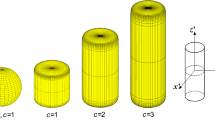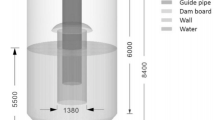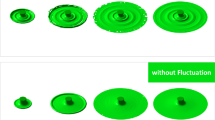Abstract
In this study, a continuous and airtight twin-spiral dryer was developed in accordance with the characteristics and challenges in the process of disposing polysilicon slurry. Computational fluid dynamics (CFD) simulations were used to investigate the flow field in the rotating twin-spiral continuous dryer and an original discrete phase model was also elaborated to compare with the cold-modeling experimental results. The corresponding flow field was obtained using the available inlet velocity of 0.05–0.3 m/s and the rotational speed of the inner cone of 12–44 r/min, the residence time distribution, and tracked particles trajectory. Results showed that the residence time of the tracer particles in the cone cylinder was about 15.8–25.4% of the time spent out of it, and the particle’s residence time was much shorter in contrast to the rotational speed and inlet velocity. The external ribbon had a larger influence on the fluid, thereby leading to a larger velocity in the region outside the cone compared to that in the region inside the cone. In addition, the appearance of the vortex and boundary layer separation at the back of the ribbon and the spoke bar had secondary diversion effects on the fluid. Furthermore, the inlet velocity had little influence on the flow field while the rotational speed of the cone greatly affected the flow field. Hence, the CFD simulations showed good agreement with the experimental results.













Similar content being viewed by others
References
Bu XP (2008) Market status and development trend of silicon industry. Chem Ind 26(7):32–41 (in Chinese)
Ran Y, Lan TS, Qin P et al (2007) Silicon tetrachloride direct reduction to polysilicon in the plasma system. J Synth Cryst 36(4):828–831 (in Chinese)
Wen Y, Hu YD, Shan TL (2008) Improvements of separating process in polycrystalline silicon production by modified Siemens arts and crafts. Chem Ind Eng 25(2):154–159 (in Chinese)
Seifert DA, Browning MF (1982) Pilot-scale development of the zinc reduction process for production of high-purity silicon. Process Energy Met Miner 218(78):104–118
Jamaleddine TJ, Ray MB (2010) Application of computational fluid dynamics for simulation of drying processes: a review. Dry Technol 28(2):120–154
Yang T (2009) The discussion of the improved Siemens process for polysilicon in design. Guizhou Chem Ind 34(3):7–11 (in Chinese)
Liu G, Qin R, Liu SZ et al (2013) Improvement on rectification process of polycrystalline silicon by improved Siemens process. Nonferrous Metal (Extr Metall) 9:56–59 (in Chinese)
Li QS, Wang XY (2015) Optimization of the distillation process of trichlorosilane using the response surface method. J Beijing Univ Chem Technol (Nat Sci Edn) 42(1):16–20 (in Chinese)
Li GD, Zhang XL, Hu YD (2007) Thermodynamic analysis of production technology of electronic grade polycrystalline silicon. Chin J Process Eng 7(3):520–525 (in Chinese)
Jiang LX, Wan Y, Si WX et al (2014) A low energy-consumption distillation process for dealing with cold hydrogen material. Chem Enterp Manag 12:91–92 (in Chinese)
Pirayesh H, Cadien K (2016) The effect of slurry properties on the CMP removal rate of boron doped polysilicon. ECS J Solid State Sci Technol 5(5):233–238
Sun HY, Li T, Ying WY et al (2010) Experimental study on bubble behavior and CFD simulation of large-scale slurry bubble column reactor. Front Chem Sci Eng 4(4):515–522
Jaskulski M, Wawrzyniak P, Zbicinski I (2015) CFD model of particle agglomeration in spray drying. Dry Technol 33(15/16):1971–1980
Keshani S, Montazeri MH, Daud WRW et al (2015) CFD modeling of air flow on wall deposition in different spray dryer geometries. Dry Technol 33(7):784–795
Yakhot V, Orszag SA (1986) Renormalization-group analysis of turbulence. I. Basic theory. J Sci Comput 1(1):3–51
Zhang MH, Meng F, Geng ZF (2015) CFD simulation on shell-and-tube heat exchangers with small-angle helical baffles. Front Chem Sci Eng 9(2):183–193
Launder BE, Spalding DB (1974) The numerical computation of turbulent flows. Comput Methods Appl Mech Eng 3(2):269–289
Ebrahimifakhar M, Mohsenzadeh E, Moradi S et al (2011) CFD simulation of the hydrodynamics in an internal air-lift reactor with two different configurations. Front Chem Sci Eng 5(4):455–462
Fluent Inc (2003) FLUENT user’s guide. USA
Lin JZ (2003) Fluid-soild two-phase coherent vortex flow and hydrodynamic stability. Tsinghua University Press, Beijing
Johnson KL (1985) Contact mechanics. Cambridge University Press, Cambridge
Felzenszwalb PF, Girshick RB, McAllester D et al (2010) Object detection with discriminatively trained part-based models. IEEE Trans Pattern Anal Mach Intell 32(9):1627–1645
Tian ZJ (2005) Two-phase rotating flow field simulation and analyses in spouted rotating-fluidized bed. School of Chemical Engineering and Technology, Tianjin University, China (in Chinese)
Author information
Authors and Affiliations
Corresponding author
Rights and permissions
About this article
Cite this article
Wang, X., Li, Y., Ma, D. et al. Hydrodynamics of Continuous Spiral Dryer with Rotatory Conical Sleeves: Experiments versus CFD Simulations. Trans. Tianjin Univ. 23, 511–520 (2017). https://doi.org/10.1007/s12209-017-0071-0
Received:
Revised:
Accepted:
Published:
Issue Date:
DOI: https://doi.org/10.1007/s12209-017-0071-0




